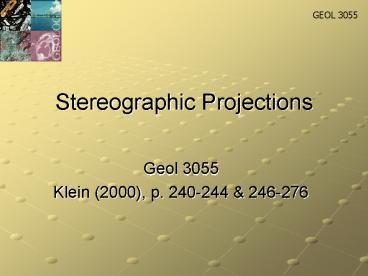Stereographic Projections PowerPoint PPT Presentation
1 / 13
Title: Stereographic Projections
1
Stereographic Projections
- Geol 3055
- Klein (2000), p. 240-244 246-276
2
How a spherical projection is produced
CRYSTAL PROJECTIONS represents the 3-D crystal
shape on 2-D surface
- Imagine a crystal inside a big transparent beach
ball with a small, bright point of source light. - Use pinholes to see the light passing through
perpendicular to all the crystals faces - Using the light points on each face, mark the
faces in the inside of the ball (see Fig 6.3 p.
242 Klein) - Each face represented by a point is called a face
pole - A stereographic projection is half (the northern
hemisphere) of the spherical projection
3
001
Developing a Spherical Projection
-100
0-10
010
100
00-1
4
Stereographic projections
Fig 6.3 Spherical projection of an isometric
crystal
5
Stereographic projections
Plane of half the spherical projection (N
hemisphere)
Plane of projection -equatorial plane of sphere
Primitive Circle outlining projection -equator
Fig 6.5 Relationship between spherical
stereographic projection
NOTE Line of sight between face poles S pole
produces new POLES
6
Stereographic projections
7
Stereographic projections
This is a stereographic projection of an
isometric crystal with the faces identified by
Miller indices
8
Stereographic projections
- Making stereographic projections of crystals is
great fun - unfortunately we will not do this in this class
- But you must know how to read them
9
Stereographic projections
- Symmetry elements present
- Two fold axis
- Mirror
- Monoclinic crystal system, 2/m
- Monoclinic prism
10
Stereographic projections
- Symmetry elements present
- 3 two-fold axes
- 3 mirrors
- Orthorhombic (2/m2/m2/m)
11
Stereographic projections
- Symmetry elements present
- 5 mirrors
- 1 four-fold axis
- 4 two-fold axes
- Tetragonal Crystal system 4/m2/m2/
- Crystal Form is a Ditetragonal bipyramid
12
Stereographic projections
- Symmetry elements present
- 7 mirrors
- 6 two-fold axes
- 1 six-fold axis
- Hexagonal crystal system 6/m2/m2/m
- Crystal form is a Dihexagonal bipyramid
13
1
1
2
2
3
3
4
- Symmetry elements present
- 3 four-fold axes
- 4 three fold (rotoinversion) axes
- 6 two-fold axes
- 9 mirrors
- Isometric crystal system crystal form is a
Hexoctahedron
14
- Symmetry elements present
- 3 four-fold (rotoinversion) axes
- 4 three fold axes
- 6 mirrors
- Isometric system
- Hexa tetrahedral class

